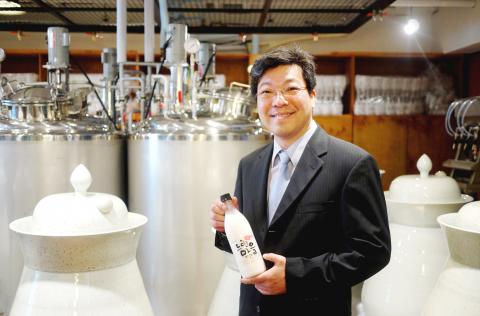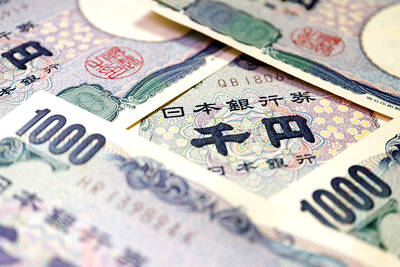A centuries-old Korean rice wine is enjoying a renaissance in South Korea and in Japan, and is set to make inroads into a major new market as it gains ground on better known beverages such as soju.
Makgeolli, a smooth milky-white drink famed for its purported health benefits, will be produced overseas for the first time later this year when a brewery opens in Chicago, South Korea’s Baesangmyun Brewery has announced.
Under a deal with an entrepreneur based in the US city, some 50,000 bottles a month of makgeolli will be produced, a spokeswoman for the company said.

Warning: Excessive consumption of alcohol can damage your health
Photo: AFP
“This will be the first makgeolli brewery outside the country,” she said, without being drawn on the cost.
Makgeolli, once known as “farmer drink”, dates back at least to the 10th century. Its popularity waned in the early 1960s when the government restricted the use of rice for making alcohol in order to combat rice shortages. Unpopular wheat-based varieties caused drinkers to turn to beer and other liquors. In 1989 authorities authorized the use of rice for brewing but it took at least a decade for makgeolli to regain its reputation and market share.
In recent years improved recipes and a claimed nutritional value have sent sales soaring and made it a fashionable drink in Seoul’s upscale bars.
Production in South Korea surged 48 percent year-on-year in 2009 and 58 percent in 2010, when makgeolli’s market share was 12 percent compared to about 4 percent in 2002.
Makgeolli exports hit $52.8 million last year, up 176 percent from a year earlier and a twelvefold rise from 2008.
The increase mostly stemmed from Japan, which absorbed 92 percent of total exports last year, up 211 percent from the previous year.
Tax service figures show makgeolli still far behind its better-known rival beverage soju but the gap is shrinking.
Makgeolli production rose from 260,640 kiloliters in 2009 to 412,269 kiloliters in 2010. Production of soju, which normally has an alcohol content of around 20 percent, increased from 930,020 kiloliters in 2009 to 931,322 kiloliters in 2010.
The Baesangmyun spokeswoman attributed makgeolli’s surge in popularity at home and overseas to its supposed health effects and a government-led campaign to promote Korean food and drink globally.
Riding the wave of South Korean pop culture that swept Asia and other parts of the world, South Korea in 2008 launched a campaign to globalize its cuisine.
This included setting up Korean culinary schools abroad, developing and propagating standard recipes and offering cheap loans to local restaurants which wanted to open overseas branches.
Baesangmyun CEO Bae Young-Ho has said he believes makgeolli can help turn American taste buds to Korean food.
The slightly sweet and sour beverage, with an alcohol volume of between 6 percent and 8 percent, is the perfect accompaniment to many Korean dishes — especially traditional pancakes and steamed pork wrapped in kimchi.
Professor Lee Dong-Ho of Seoul National University Hospital has described makgeolli as a healthy drink full of vitamins, fiber and beneficial micro-organisms.
“Apart from the alcohol, drinking makgeolli is like drinking nutritional supplements,” Lee was quoted as telling Health Chosun magazine.
Makgeolli has already made its US debut, with shipments there growing ninefold between 2008 and 2011 to US$1.9 million. But while salgyun (sterilized) makgeolli must be used for exports, saeng (unsterilized) makgeolli will be brewed in Chicago. Because the yeast is still fermenting in saeng makgeolli, it must be produced locally and drunk quickly.
Raw materials such as rice and nuruk — yeast cakes composed of wheat, rice and barley with fermenting micro-organisms — will be shipped from Seoul.
The company also hopes to open breweries in San Francisco and Los Angeles.

AI TALENT: No financial details were released about the deal, in which top Groq executives, including its CEO, would join Nvidia to help advance the technology Nvidia Corp has agreed to a licensing deal with artificial intelligence (AI) start-up Groq, furthering its investments in companies connected to the AI boom and gaining the right to add a new type of technology to its products. The world’s largest publicly traded company has paid for the right to use Groq’s technology and is to integrate its chip design into future products. Some of the start-up’s executives are leaving to join Nvidia to help with that effort, the companies said. Groq would continue as an independent company with a new chief executive, it said on Wednesday in a post on its Web

RESPONSE: The Japanese Ministry of Finance might have to intervene in the currency markets should the yen keep weakening toward the 160 level against the US dollar Japan’s chief currency official yesterday sent a warning on recent foreign exchange moves, after the yen weakened against the US dollar following Friday last week’s Bank of Japan (BOJ) decision. “We’re seeing one-directional, sudden moves especially after last week’s monetary policy meeting, so I’m deeply concerned,” Japanese Vice Finance Minister for International Affairs Atsushi Mimura told reporters. “We’d like to take appropriate responses against excessive moves.” The central bank on Friday raised its benchmark interest rate to the highest in 30 years, but Bank of Japan Governor Kazuo Ueda chose to keep his options open rather than bolster the yen,

Even as the US is embarked on a bitter rivalry with China over the deployment of artificial intelligence (AI), Chinese technology is quietly making inroads into the US market. Despite considerable geopolitical tensions, Chinese open-source AI models are winning over a growing number of programmers and companies in the US. These are different from the closed generative AI models that have become household names — ChatGPT-maker OpenAI or Google’s Gemini — whose inner workings are fiercely protected. In contrast, “open” models offered by many Chinese rivals, from Alibaba (阿里巴巴) to DeepSeek (深度求索), allow programmers to customize parts of the software to suit their

Global server shipments are expected to surge to 15 million units next year, from 4 million units this year, with artificial intelligence (AI) servers accounting for about 30 percent, driven by massive capital spending by major cloud service providers, the Market Intelligence and Consulting Institute (MIC) said on Thursday last week. Major cloud service providers — including Google’s parent company Alphabet Inc, Microsoft Corp, Amazon.com Inc and Meta Platforms Inc — are projected to budget US$450 million for capital expenditure next year, up from US$400 million this year, MIC ICT [information and communications technology] Industry Research Center director Edward Lin